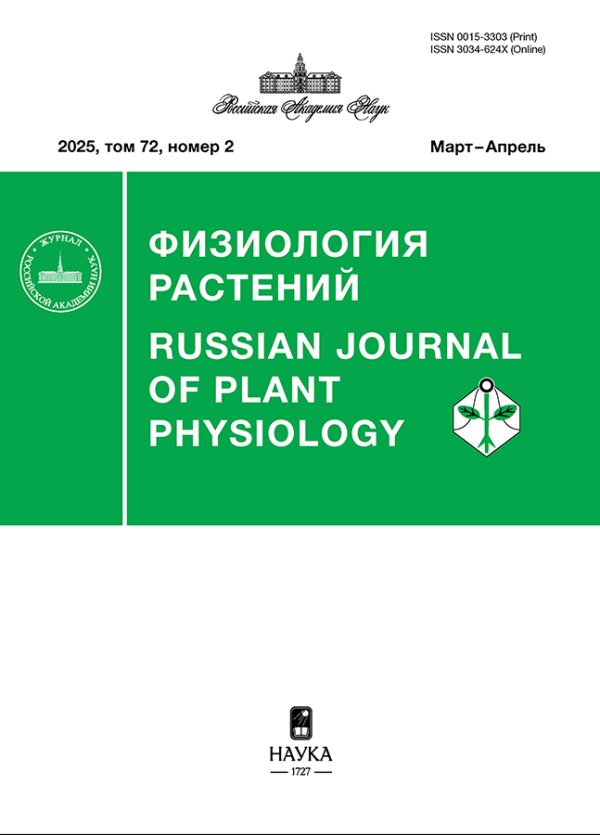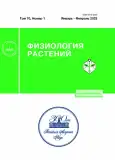Effect of Brassinosteroids on the Ion-Exchange Properties of the Cell Walls of Barley Roots and Shoots under the Action of Heavy Metals
- Authors: Meichik N.R.1, Nikolaeva Y.I.1, Efimova M.V.2, Danilova E.D.2, Nikushin O.V.1, Kushunina M.A.1
-
Affiliations:
- Lomonosov Moscow State University
- Tomsk State University
- Issue: Vol 70, No 1 (2023)
- Pages: 91-99
- Section: ЭКСПЕРИМЕНТАЛЬНЫЕ СТАТЬИ
- URL: https://journals.rcsi.science/0015-3303/article/view/130214
- DOI: https://doi.org/10.31857/S0015330322600474
- EDN: https://elibrary.ru/AMMZYE
- ID: 130214
Cite item
Full Text
Abstract
The effect of polymetallic contamination and concomitant treatment with brassinosteroids (homocastasterone or homobrassinolide) on barley plants and on the ion-exchange capacity of cell walls isolated from shoots and roots was studied. Under the influence of polymetals, a decrease in the dry mass of roots, water content, and the proportion of the cell wall in them was observed, but the addition of homocastasterone to the medium led to the restoration of these parameters almost to the control level. In the aerial part of plants, the influence of both polymetals and brassinosteroids on these parameters was weakly expressed. In the presence of homocastasterone, the content of demethylated carboxyl groups of polygalacturonic acid increased in the pectins of the cell walls of roots and leaves, which are the main binding sites for heavy metal ions in the apoplast. Thus, it can be assumed that treatment with brassinosteroids (homocastasterone) leads to a change in the composition and ion-exchange properties of the cell wall, which makes it possible to reduce the toxic effect of polymetals due to their immobilization in the apoplast.
About the authors
N. R. Meichik
Lomonosov Moscow State University
Email: meychik@mail.ru
Russian Federation, Moscow
Yu. I. Nikolaeva
Lomonosov Moscow State University
Email: meychik@mail.ru
Russian Federation, Moscow
M. V. Efimova
Tomsk State University
Email: meychik@mail.ru
Russian Federation, Tomsk
E. D. Danilova
Tomsk State University
Email: meychik@mail.ru
Russian Federation, Tomsk
O. V. Nikushin
Lomonosov Moscow State University
Email: meychik@mail.ru
Russian Federation, Moscow
M. A. Kushunina
Lomonosov Moscow State University
Author for correspondence.
Email: meychik@mail.ru
Russian Federation, Moscow
References
- Kour J., Kohli S.K., Khanna K., Bakshi P., Sharma P., Singh A.D., Ibrahim M., Devi K., Sharma N., Ohri P., Skalicky M., Brestic M., Bhardwaj R., Landi M., Sharma A. Brassinosteroid signaling, crosstalk and, physiological functions in plants under heavy metal stress // Front. Plant Sci. 2021. V. 12. P. 608061. https://doi.org/10.3389/fpls.2021
- Rajewska I., Talarek M., Bajguz A. Brassinosteroids and response of plants to heavy metals action // Front. Plant Sci. 2016. V. 7. P. 629. https://doi.org/10.3389/fpls.2016.00629
- Hayat S., Hasan S.A., Hayat Q., Ahmad A. Brassinosteroids protect Lycopersicon esculentum from cadmium toxicity applied as shotgun approach // Protoplasma. 2010. V. 239. P. 3. https://doi.org/10.1007/s00709-009-0075-2
- Sharma P., Bhardwaj R., Arora N., Arora H.K. Effect of 28-homobrassinolide on growth, zinc metal uptake and antioxidative enzyme activities in Brassica juncea L. seedlings // Braz. J. Plant Physiol. 2007. V. 19. P. 203. https://doi.org/10.1590/S1677-04202007000300004
- Sharma P., Kumar A., Bhardwaj R. Plant steroidal hormone epibrassinolide regulate – Heavy metal stress tolerance in Oryza sativa L. by modulating antioxidant defense expression // Environ. Exp. Bot. 2016. V. 122. P. 1. https://doi.org/10.1016/j.envexpbot.2015.08.005
- Ali B., Hasan S.A., Hayat S., Hayat Q., Yadav S., Fariduddin Q., Ahmad A. A role for brassinosteroids in the amelioration of aluminum stress through antioxidant system in mung bean (Vigna radiata L. Wilczek) // Environ. Exp. Bot. 2008. V. 62. P. 153. https://doi.org/10.1016/j.envexpbot.2007.07.014
- Abdullahi B.A., Gu X.-G., Gan Q.-L., Yang Y.-H. Brassinolide amelioration of aluminium toxicity in mung bean seedling growth // J. Plant Nutr. 2003. V. 26. P. 1725. https://doi.org/10.1081/PLN-120023278
- Fariduddin Q., Khanam S., Hasan S.A., Ali B., Hayat S., Ahmad A. Effect of 28-homobrassinolide on the drought stress-induced changes in photosynthesis and antioxidant system of Brassica juncea L. // Acta Physiol. Plant. 2009. V. 31. P. 889. https://doi.org/10.1007/s11738-009-0302-7
- Ramakrishna B., Rao S.S.R. Foliar application of brassinosteroids alleviates adverse effects of zinc toxicity in radish (Raphanus sativus L.) plants // Protoplasma. 2015. V. 252. P. 665. https://doi.org/10.1007/s00709-014-0714-0
- Kozuka T., Kobayashi J., Horiguchi G., Demura T., Sakakibara H., Tsukaya H., Nagatani A. Involvement of auxin and brassinosteroid in the regulation of petiole elongation under the shade // Plant Physiol. 2010. V. 153. P. 1608. https://doi.org/10.1104/pp.110.156802
- Bashline L., Lei L., Li S.D., Gu Y. Cell wall, cytoskeleton, and cell expansion in higher plants // Mol. Plant. 2014. V. 7. P. 586. https://doi.org/10.1093/mp/ssu018
- Rao X., Dixon R.A. Brassinosteroid mediated cell wall remodeling in grasses under abiotic stress // Front. Plant Sci. 2017. V. 8. P. 806. https://doi.org/10.3389/fpls.2017.00806
- Qu T., Liu R.F., Wang W., An L.Z., Chen T., Liu G.X., Zhao Z. Brassinosteroids regulate pectin methylesterase activity and AtPME41 expression in Arabidopsis under chilling stress // Cryobiology. 2011. V. 63. P. 111. https://doi.org/10.1016/j.cryobiol.2011.07.003
- Shen H., Mazarei M., Hisano H., Escamilla-Trevino L., Fu C.X., Pu Y.Q., Rudis M.R., Tang Y., Xiao X., Jackson L., Li G., Hernandez H., Chen F., Ragauskas A.J., Stewart C.N., et al. A genomics approach to deciphering lignin biosynthesis in switchgrass // Plant Cell. 2013. V. 25. P. 4342. https://doi.org/10.1105/tpc.113.118828
- Haynes R.J. Ion exchange properties of roots and ionic interactions within the root apoplasm. Their role in ion accumulation by plants // Bot. Rev. 1980. V. 46. P. 75. https://doi.org/10.1007/BF02860867
- Danilova E.D., Zlobin I.E., Kuznetsov V.V., Efimova M.V. Exogenic melatonin reduces the toxic effect of polymetallic stress on barley plants // Doklady Biochemistry and Biophysics. 2021. V. 499. P. 228. https://doi.org/10.1134/S1607672921040049
- Meychik N.R., Yermakov I.P. Ion exchange properties of plant root cell walls // Plant Soil. 2001. V. 234. P. 181. https://doi.org/10.1023/A:1017936318435
- Meychik N.R., Yermakov I.P. A new approach to the investigation on the ionogenic groups of root cell walls // Plant Soil. 1999. V. 217. P. 257. https://doi.org/10.1023/A:1004675309128
- Meychik N., Nikolaeva Y., Kushunina M., Yermakov I. Are the carboxyl groups of pectin polymers the only metal-binding sites in plant cell walls? // Plant Soil. 2014. V. 381. P. 25. https://doi.org/10.1007/s11104-014-2111-z
- Mohnen D. Pectin structure and biosynthesis // Current Opinion in Plant Biology. 2008. V. 11. P. 266. https://doi.org/10.1016/j.pbi.2008.03.006
- Colzi I., Arnetoli M., Gallo A., Doumett S., Del Bubba M., Pignattelli S., Gabbrielli R., Gonnelli C. Copper tolerance strategies involving the root cell wall pectins in Silene paradoxa L. // Environ. Exp. Bot. 2012. V. 78. P. 91. https://doi.org/10.1016/j.envexpbot.2011.12.028
- Liu T., Shen C., Wang Y., Huang C., Shi J. New insights into regulation of proteome and polysaccharide in cell wall of Elsholtzia splendens in response to copper stress // PLoS One. 2014. V. 9: e109573. https://doi.org/10.1371/journal.pone.0109573
- Eticha D., Stass A., Horst W.J. Cell-wall pectin and its degree of methylation in the maize root-apex: significance for genotypic differences in aluminium resistance // Plant, Cell Environ. 2005. V. 28. P. 1410. https://doi.org/10.1111/j.1365-3040.2005.01375.x
- Meychik N., Nikolaeva Yu., Kushunina M., Yermakov I. Contribution of apoplast to short-term copper uptake by wheat and mung bean roots // Funct. Plant Biol. 2016. V. 43. P. 403. https://doi.org/10.1071/FP15356
- Meychik N., Nikolaeva Yu., Kushunina M. The role of the cell walls in Ni binding by plant roots // J. Plant Physiol. 2019. V. 234. P. 28. https://doi.org/10.1016/j.jplph.2019.01.008
- Meychik N.R., Nikolaevaa Yu.I., Nikushina O.V., Kushuninaa M.A. The Effect of Polymetallic Pollution on Ion-Exchange Properties of Barley Root and Shoot Cell Walls // Doklady Biochemistry and Biophysics. 2021. V. 501. P. 415. https://doi.org/10.1134/S160767292106003X
- Gabbrielli R., Pandolfini T., Espen L., Palandri M.R. Growth, peroxidase activity and cytological modifications in Pisum sativum seedlings exposed to Ni2+ toxicity // J. Plant Physiol. 1999. V. 155. P. 639. https://doi.org/10.1016/S0176-1617(99)80066-2
- Pandey N., Sharma C.P. Effect of heavy metals Co2+, Ni2+ and Cd2+ on growth and metabolism of cabbage // Plant Sci. 2002. V. 163. P. 753. https://doi.org/10.1016/S0168-9452(02)00210-8
Supplementary files










